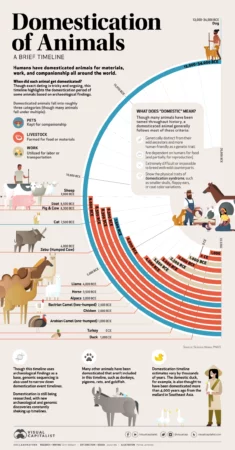 Pretty good infographic on the history of animal domestication from the oddly named Visual Capitalist. References and a map would be good, but we mustn’t…ahem…look a gift horse in the mouth.
Pretty good infographic on the history of animal domestication from the oddly named Visual Capitalist. References and a map would be good, but we mustn’t…ahem…look a gift horse in the mouth.
Brainfood: Rice domestication, Roman wine, Dog domestication, Earth ovens, Forest orchards, Saffron origins
- The Fits and Starts of Indian Rice Domestication: How the Movement of Rice Across Northwest India Impacted Domestication Pathways and Agricultural Stories. While cultivation of (indica) rice in South Asia began in the Ganges around 6500 BC, its domestication really speeded up 3000 years later in the Indus.
- Archaeobotanical and chemical investigations on wine amphorae from San Felice Circeo (Italy) shed light on grape beverages at the Roman time. In the second century BC the ancient Romans may have traded a medicinal wine made from wild or semi-domesticated grapevines. I wonder how it would have gone with a nice risotto.
- Grey wolf genomic history reveals a dual ancestry of dogs. Either dogs were domesticated independently in E and W Eurasia and then the two lineages merged, or they were domesticated in the E and then there was geneflow from wild dogs. Sounds a bit like rice actually. 1
- Bulbs and Biographies, Pine Nuts and Palimpsests: Exploring Plant Diversity and Earth Oven Reuse at a Late Period Plateau Site. For 2000 years Native Americans returned to specific food processing sites dug into the soil to cook up a storm. No word on the use of wild grapevines.
- Coupled archaeological and ecological analyses reveal ancient cultivation and land use in Nuchatlaht (Nuu-chah-nulth) territories, Pacific Northwest. Native Americans nurtured forest gardens to enrich them with edible species. Including wild apples though again not wild grapevines apparently.
- Ancient Artworks and Crocus Genetics Both Support Saffron’s Origin in Early Greece. Ok now everything is in place for a nice risotto alla Milanese with a Falanghina at the House of the Tragic Poet.
Nibbles: Animal genebanks, Wild pigeon, Uganda genebank, Biodiversity value, W African cooking, Indigenous cafes, Climate crisis & food, Reforestation
- FAO webinar series on animal genebanks.
- Quick put this wild pigeon in a genebank before it’s too late. No, really.
- Yeah but how much is a wild pigeon worth?
- Maybe if you could cook it, it might be worth more? No, really, I’m serious.
- Would be terrible to have a wild pigeon shortage.
- In fact, we need to be able to re-pigeon.
The trouble with buffel grass
Cenchrus ciliaris (buffel grass) is a valued forage and fodder species both in Africa and the regions of Asia where it is native, and in the other parts of the sub-humid and semi-arid tropics and subtropics where it has become naturalized or is cultivated.
“The buffel grass has been there from the days of my father, grandparents to my great grandparents,” says [Geoffrey] Letakaan [of Baringo County, Kenya]. “This grass has a lot of value. If fed to cows, they fatten within three months. There is also hay for baling, and it is also used for thatching. In the past, the elders used to say ‘nangrongong’, meaning ‘it (the buffel grass) is on the hills’ such as Arabal and Mukutani hills… People should plant this grass – everyone.”
There are almost 4000 accessions in genebanks around the world, which are being genotyped, phenotyped and improved.
And yet, not all is well, as a tweet from GRAIN recently alerted me.
In Australia, where the grass is introduced, it is becoming a serious threat to native wildlife and habitats, with calls for its extirpation in some areas.
It’s … important to note controlling buffel doesn’t require its eradication from pastoral regions where it’s valued. It does, however, require a national commitment and dedicated research, with strategic, coordinated and committed action.
And even back in its native African range, specifically in the Baringo region of Kenya, there are problems. According to GRAIN:
Over the past few decades, a man named Murray Roberts, known to locals as “Omari” has led an effort to try and transform the local management of buffel grass – from a system based on communal land ownership and pastoralism to one based on private landholdings and intensive farming.
The issue is Roberts’ application for plant breeders’ rights over a number of buffel grass varieties, starting about 10 years back.
For many local pastoralists, Roberts is trying to claim ownership over their biodiversity. Eresia Erige, a Baringo community member, says that as soon as the community became aware of Roberts’ application for a breeders’ right, local elders went up the hills and collected samples to compare with the varieties grown by RAE. They found that it was the same grass. For Erige, “The grass belongs to the hills and therefore, its seeds and farming in general should be for all and not be privatised.”
The tug-of-war between Roberts and the Baringo pastoralists continues.
In both Australia and Kenya, buffel grass is affecting the welfare of Indigenous communities, in one case by threatening cultural sites, in the other by what is seen as an attempt to control access to its diversity. In neither case have the local communities had much of a say.
Nibbles: Livestock genebank, Purple grain, Traditional Hawaiian farming
- Call to set up a sheep genebank in Australia. Kinda surprised there isn’t one already, frankly.
- Bringing back purple wheat in the US. Spoiler alert: genebanks were involved.
- Going back to “organized chaos” in Hawaiian farming. There’s probably room for genebanks too, though.